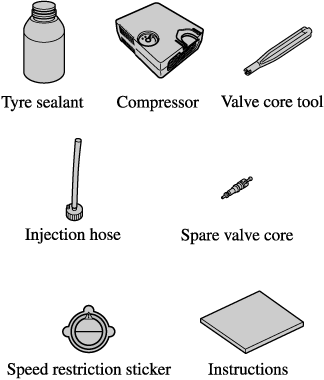

About the Emergency Flat Tyre Repair Kit
The emergency flat tyre repair kit includes the following items.

Do not allow children to touch the tyre sealant:
-
Ingestion of tyre sealant is dangerous. In the event tyre sealant is accidentally swallowed, drink large amounts of water immediately and seek medical assistance.
-
Tyre sealant that comes into contact with the eyes and skin is dangerous. If tyre sealant enters the eyes or contacts the skin, flush immediately with large amounts of water and seek medical assistance.
-
The tyre sealant cannot be reused. Purchase new tyre sealant at an Authorised Mazda Repairer.
-
The emergency flat tyre repair kit cannot be used in the following cases.
Consult an expert repairer (we recommend an Authorised Mazda Repairer).
-
The period of effective use for the tyre sealant has expired. (The period of effectiveness is indicated on the bottle label.)
-
The tear or puncture exceeds about 4 mm (0.16 in).
-
The damage has occurred to an area of the tyre other than the tread.
-
The vehicle has been driven with nearly no air remaining in the tyre.
-
The tyre has come off the wheel rim.
-
Damage to the wheel rim has occurred.
-
The tyre has 2 or more punctures.
-




